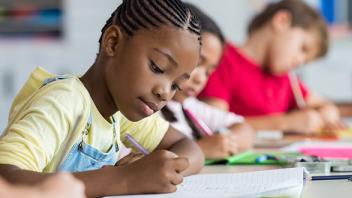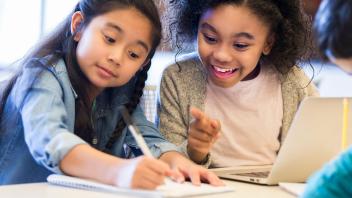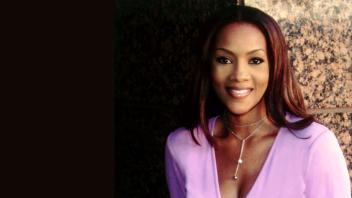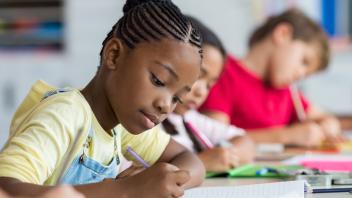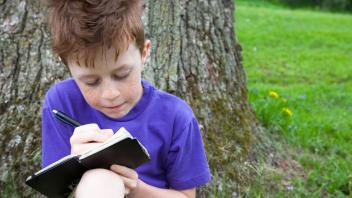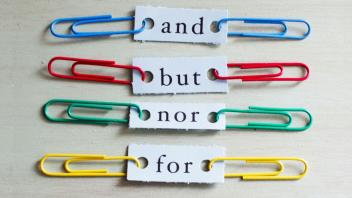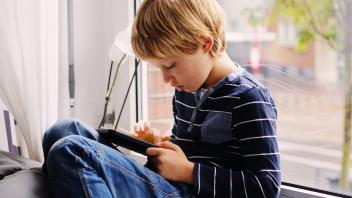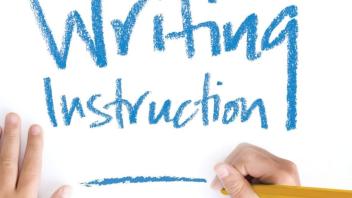Shana: So boys and girls we have a new featured author. Her name is Erica Perl.
Narrator: Featuring an author on a class bulletin board is great.
Shana: Let’s share this book today called Dotty that she wrote.
Narrator: Enjoying one of her books together is even better.
Shana: Thirteen, she silently added. Whose nose did she want to count?
Students: Dotty’s
Shana: Dotty’s
Narrator: Meeting her in person…
Students: Erica!
Narrator: Amazing!
Students: Ooh!
Shana: Our featured author’s here!
Narrator: Author visits may seem like just fun and games but they can have a major impact on students.
Rogers: Students will sit in rapt attention listening, engaging, asking questions and if that author will talk to those students as fellow writers, it is so affirming.
Erica: I thought that we could read Dotty together and I could tell you a little bit about kinda how I wrote it. And I could hear about the kind of stuff you guys are writing. Maybe we could even do some writing together. What do you think?
Student: Yeah.
Erica: Now, everyone here brought their imagination today right?
Students: Yes.
Erica: Good
Boy: I forgot mines at home.
Students: (laughing)
Erica: You left your imagination at home. That’s not good. You’re going to have to go get it right now.
Narrator: Reading aloud to students engages them with the written word and gets them excited about books.
Erica: So when Ida started school, she took her new lunchbox, and…
Students: Dotty.
Erica: I am a huge fan of reading aloud and I really believe that it should be the most fun part of a teacher or a parent’s day.
Erica: Ahhh!
Erica: Because if you’re enjoying it, the kids will enjoy it. So I think getting excited about the books that you’re sharing, getting silly with them, I think that all hugely important.
Erica: Say it all together. Ready?
Students: Wham!
Narrator: Writing can seem a daunting task to students. And while teachers can offer a lot of guidance, instruction, and practice, a published author has real-world weight behind her words.
Erica: Because they all start with an idea, right? And so, in the case of Dotty, when I was growing up I had all these friends. Right? Friends, just like you guys. Alright. But, I also had some friends who not everybody else could see. What do you think is a good thing about seeing something nobody else can see?
Girl: You have real friends, but some kids make fun of you, that you don’t have friends but you really do.
Erica: And your imaginary friends, would they ever make fun of you?
Girl: No.
Eric : No way.
Erica: When I go and talk to kids about writing. I always tell them that the thing about writing fiction, is that it has to have a truth in it. It has to have an emotional truth. And so, for me, in every book that I write, there’s an emotional truth that comes from my life and my experience. And so, with Dotty, the story of having an imaginary friend was a story that I could relate to when I look back on my own experience as a kid.
Erica: I would always worry that if people knew about Dotty they would say “Oh my goodness. Have you heard about Erica? Bah ha ha.” And they would laugh. So, I didn’t tell people, but I always wrote my ideas down, or I drew them. So, this is sort of a storyboard, of the story of Dotty. And as you can see, I drew these little sketches like here’s Ida here. She’s walking to school. And then, there’s Dotty who still looks sort of like a goat.
Narrator: Erica is showing the students that there are many ways to start writing and they don’t always involve using words.
Erica: So, I started drawing the class, and drawing my ideas out because sometimes that’s how I get my ideas flowing. And then, usually I write the words down in one of my journals. Do you guys do this? Raise your hand if you do this. Do you guys write stuff down just in writer’s notebooks? Because, my idea’s if you don’t write it down it kind of flutters away. But I don’t just write stories in it and I like it to get good and messy.
Narrator: The writer’s notebook is a great tool for encouraging daily writing from students. Keeping it free from grading, and the red ink of a correction pen, helps students see it as a pressure-free outlet for their ideas.
Erica: And then, sometimes I will get on the computer. Raise your hand if you ever get on the computer and do some writing there. Yep. And I start taking my ideas and putting them onto paper on the computer. And then I go through and change things, little things here and there. I revise it. Do you guys revise? Okay. Yes?
Students: Yes!
Erica: Yes! Good! Because if your revising, you’re writers. That’s a huge part of the writing process. You don’t just show up day one and write and you’re done.
Narrator: Revising can be one of the trickiest things for students to understand, but it’s also one of the most important steps in the writing process. Learning that a professional writer has to revise, often multiple times, is a terrific learning experience for young writers. Not even professional, adult authors are perfect!
Erica: ‘Cause I never get it just the way I want it the first time, and so I start kinda changing it around. So I go through it a million zillion times changing ideas. And you’ll see that some of these things ended up in Dotty and some of them didn’t. And I also read it out loud to kids.
Narrator: A key component to the revising process is peer editing. Once the students understand how to give constructive feedback, sharing their work with each other will result in stronger writing and more confident writers. And this is a message Erica is happy to underscore.
Erica: Sometimes I talk to my grown up writer friends and sometimes I talk to my kid writer friends, and we all talk about how the story can get better. Like a big collaboration. Do you guys do that? Do you share your work with each other?
Students: Yes.
Erica: Again another important part of the writing process, is sharing your work. So now we’re going to make a story together!
Students: Yay!
Erica: Yay! Okay.
Narrator: Group writing a story with students is a great way to have fun, while checking their understanding of story elements.
Erica: What does a story need to have? Yes!
Boy: Characters!
Erica: Characters! Characters! Okay. So, we gotta have some characters! Okay. What else?
Student: Words
Erica: Characters.
Boy: Setting!
Erica: And setting okay.
Erica: We’re going to put.
Student : Plot
Erica: Plot. What does plot mean?
Students: Beginning, middle, and end.
Erica: Beginning, middle, and end. Everybody give me some beginning, middle, and end.
All: Beginning, middle, and end.
Erica: Yeah! Okay, plot.
Student: The theme.
Erica: Theme, okay What does theme mean?
Student: Um. What it’s all about.
Student: Oh, the message.
Erica: The message. What has to happen in the middle? Something that has to happen in
the middle of the story. To make it dramatic. Or surprising!
Student: Drama!
Erica: Drama, would be good. Yeah.
Student: Problem.
Erica: Some sort of…thank you.! Say that again.
Student: Problem
Erica: Problem! We have to have a problem.
Student: And solution!
Erica: And solution!
Narrator: Erica is going to keep the class active by having each student represent an element of the story.
Erica: Okay. Okay, I’m going to need two people to be the characters.
Students: Me! Me!
Erica: Okay. You and you.
Student: A baby with giant diapers!
Erica: A baby with giant diapers. No, no, no, no.
Student 2: Superman.
Erica: Superman. Okay we got Superman and?
Student 3: a princess
Erica: And a princess! Superman and a princess. Excellent. Okay.
Erica: Setting. Where are you guys going to be?
Student 4: I want to be the tree.
Erica: You’re a tree. Good. So, we’re sort of outdoors.
Student 5: I want to be the boy.
Erica: A boy?
Student 4: Maybe a guard.
Erica: A guard? Like a castle guard?
Student 5: Like a castle
Erica: Castle guard and tree.
Erica: Who’s going to be our problem? You two are going to be our problem. Come up here problems. What are the problems? Two problems.
Student 2: A giant monster is going to attack the city.
Erica: A giant monster is a pretty good problem. Do you guys want to be a giant monster?
Student 6: Yeah.
Student 7: Okay.
Erica: Okay. Good. We’ve got a giant monster and a castle in the woods. Let me just put giant monster behind you.
Erica: What’s our theme going to be?
Student 1: If you’re mean to someone, then someone will be mean to you.
Student 2: When you help other people, they might help you back.
Erica: Those kinda fit together. What do you guys think?
Student: Yeah.
Erica: It’s sort of like two sides to the same coin.
Student narrator: Once upon a time in a land far, far, away. There was a queen in a castle and her mother. And then, there was this green, ugly, smelly, one-eyed monster.
Erica: Let’s pause for a second, so we can see that. We’ve got the princess and the queen. Right here.
Erica: Look at the monster. Where’s the monster? There’s the monster! Let’s see some monstering.
Student monster: Grrrrr!
Erica: Good good good. Okay. Okay. Now.
Student narrator: The guard’s Omar. He came in. He tried to stop the monster, but the monster was too big and too strong.
Erica: Okay. We’ve got conflict going on, clearly the monster is having a conflict with the guard. Let’s see where we are so far. Are we at the beginning, the middle, or the end of the story?
Narrator: Erica pauses the story, because while the students are enthusiastic and engaged, it’s important to make sure that they also understand the story elements they’re acting out.
Erica: We’ve got the beginning, right? We’ve got the middle. Problem. How are we going to end it? How are we going to resolve this? And let’s remember — what’s our theme? Who said our theme so beautifully? You, said our theme so beautifully. Say it again.
Student 1: When you help somebody, when you’re nice to somebody, then someone will be nice back.
Erica: Will be nice back.
Student 4: I think the monster has to be nice because Superman takes the thorn out.
Erica: Okay, Let’s see that part acted out.
Student narrator: The monster attacked.
Student monster: Grrrr…
Erica: Superman. Superman, go help. Where’s the thorn. Who’s being the thorn. There you go. Good. Very good thorn removing. Excellent.
Student narrator: Can we — when he starts fighting. He just thinks why is he fighting? And then he puts his foot up and he sees it.
Erica: Oh, that’s good. That’s very good. So you discover it. Okay. So you discover the thorn. Thorn, in position.
Erica: Okay. And you discover that there’s a thorn in his tentacle! So, superman pulls the thorn from the tentacle! Okay. And then the monster says?
Students: Ahhhh!
Erica: Thank you! Awesome! That was really good. And then the princess and queen say?
Student princess and student queen: Oh, you’re my hero.
Erica: And how does the story end?
Student: And everyone lives happily ever after!
Girl: Superman and the princess get married!
Students: Yeah!
Erica: How about. How about they all…
Student: Live happily ever after.
Erica: …have friends and eat imaginary ice cream cones together.
Students: Yeah.
Erica: Yeah! And then they dance. And now, can everybody give me a nice “the end” bow? Ready? One, Two, Three. The End.
Student: For now.
